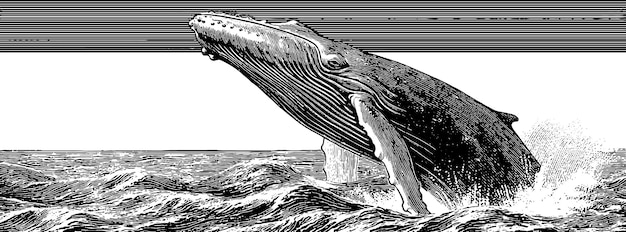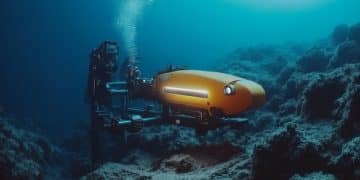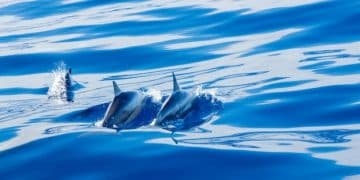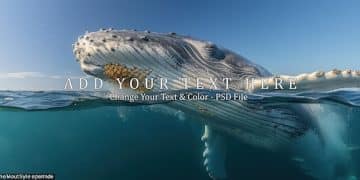Shipping Noise Pollution: Impact on Marine Life US Waters

The pervasive issue of how does noise pollution from shipping affect marine animal communication in US waters stands as a critical environmental concern, capable of profoundly disrupting vital acoustic behaviors essential for survival, reproduction, and social cohesion among diverse marine species, necessitating urgent conservation strategies.
The vast, deep blue oceans, once thought to be realms of pristine silence, are increasingly becoming cacophonous soundscapes. This auditory transformation, largely driven by human activities, presents a significant threat to the delicate balance of marine ecosystems. Specifically, understanding how does noise pollution from shipping affect marine animal communication in US waters is paramount, as the constant drone of vessels interferes with the intricate acoustic language that countless aquatic species rely upon for their very existence.
The Underwater Soundscape: A Foundation for Marine Life
The underwater world is a symphony of natural sounds, crucial for the survival and propagation of most marine species. From the clicks of dolphins and the songs of whales to the subtle chirps of fish, acoustic cues guide their daily lives. These natural sounds serve multiple vital functions, fundamentally shaping marine behavior and ecological processes.
Unlike terrestrial environments where vision often dominates, light penetrates poorly in water. Consequently, sound becomes the primary sense for navigation, foraging, mating, and predator avoidance. It is a fundamental medium through which marine animals gather information about their surroundings, enabling them to interpret the environment and interact effectively with other organisms. This reliance on sound underscores the profound impact that disruptions to the acoustic environment can have, potentially undermining the basic physiological and behavioral requirements for marine life.
Natural Sounds Versus Anthropogenic Noise
The ocean’s natural soundscape is diverse, composed of biological, geological, and physical elements. Biological sounds include vocalizations from marine mammals, fish, and invertebrates. Geological contributions range from earthquakes to volcanic activity. Physical sounds encompass waves, rain, and ice movements. This complex tapestry of natural sounds is integral to the intricate web of marine communication.
- Biological: Whale songs, dolphin clicks, fish grunts, snapping shrimp.
- Geological: Earthquakes, underwater volcanoes, sediment shifts.
- Physical: Waves, currents, rain, ice formation and melt.
Anthropogenic noise, originating from human activities, introduces a foreign element into this natural soundscape. Shipping noise, in particular, is a continuous, low-frequency sound that overlaps significantly with frequencies used by many marine animals, especially large whales. This constant influx of noise can mask crucial natural sounds, making it difficult for animals to perceive the acoustic information necessary for their survival.
Understanding these distinctions is crucial for assessing the cumulative impact of human activities on marine acoustic environments. The introduction of loud, persistent, and unnatural sounds fundamentally alters the delicate balance that marine species have evolved to thrive within, leading to potential long-term consequences for population health and ecosystem stability.
Sources of Shipping Noise in US Waters
The United States boasts an extensive network of coastal waters and inland waterways, supporting a vast commercial shipping industry. This industry, vital for global trade and local economies, inadvertently contributes significantly to marine noise pollution. The sheer volume and diversity of vessels operating within US waters generate a continuous and escalating auditory footprint.
Commercial ships, ranging from enormous cargo vessels and oil tankers to smaller fishing boats and recreational crafts, all contribute to underwater noise. The primary sources of this noise are propeller cavitation, machinery vibration, and hull turbulence. Propeller cavitation, the formation and collapse of bubbles near the propeller blades, is particularly impactful, producing broadband noise that can travel for hundreds of miles.
Types of Vessels and Their Noise Signatures
Different vessel types produce distinct noise signatures based on their size, speed, and propulsion systems. Large container ships and tankers, with their powerful engines and massive propellers, are among the loudest. Their low-frequency noise can create extensive underwater sound ‘smog’ that diminishes the habitable acoustic space for many marine species.
- Cargo Ships/Tankers: Dominant source, producing continuous low-frequency noise from propeller cavitation and engine vibrations.
- Cruise Ships: Generate significant noise due to their large size, multiple engines, and thrusters, similar to cargo vessels but often with more varied operational patterns.
- Fishing Vessels: Contribute localized noise from engines, propellers, and specialized equipment such as sonar and winches.
Beyond commercial shipping, other human activities like offshore oil and gas exploration, seismic surveys, and sonar use from naval vessels also contribute to the overall acoustic burden. While this article focuses on shipping, it’s important to recognize that these other sources compound the problem, creating a complex web of anthropogenic noise that marine animals must navigate daily. The combined effect of these diverse noise sources creates a challenging environment, forcing marine life to adapt or suffer the consequences of their inability to communicate effectively.
Impact on Marine Mammal Communication
Marine mammals, particularly whales and dolphins, are highly reliant on sound for their survival. They use vocalizations for an array of critical behaviors, from long-distance communication and social bonding to foraging and identifying mates. The introduction of shipping noise significantly interferes with these sophisticated acoustic systems.
The sounds produced by ships often overlap with the frequencies used by marine mammals, especially baleen whales (like blue and fin whales) who communicate using low-frequency sounds. This overlap leads to acoustic masking, where the ship noise effectively drowns out the animals’ signals. Imagine trying to have a conversation in a crowded, noisy room; the background din makes it incredibly difficult to hear and understand each other. For marine mammals, this difficulty can have dire consequences.
Acoustic Masking and Behavioral Changes
Acoustic masking is the primary mechanism through which shipping noise impacts marine mammal communication. When critical signals are masked, animals may exhibit several behavioral changes:
- Increased Vocalization Effort: Animals may vocalize louder or more frequently to overcome the noise, a phenomenon known as the Lombard effect. This requires more energy and can lead to fatigue.
- Changes in Vocalization Frequency or Duration: Some species might shift their vocalizations to higher frequencies to avoid the low-frequency shipping noise, while others may shorten their calls. Such shifts can reduce the effective range or clarity of their communication.
- Avoidance Behavior: Marine mammals might abandon important feeding or breeding grounds if noise levels become intolerable, leading to habitat displacement and stress.
Beyond communication, noise pollution can cause physiological stress, alter foraging patterns, and disrupt migratory routes. Chronic exposure to ship noise has been linked to elevated stress hormone levels in whale populations. The cumulative effect of these impacts can weaken individuals, reduce reproductive success, and potentially lead to population declines. The intricate lives of marine mammals are inextricably linked to sound, making them particularly vulnerable to alterations in their acoustic environment. The continued presence of ship noise poses a significant threat to their long-term viability in US waters.

Effects on Fish and Invertebrate Communication
While less overtly dramatic than the impacts on whales, the effects of shipping noise on fish and invertebrates are equally significant, if not more pervasive. Many fish species rely on sound for a range of behaviors, including mating, territorial defense, predator avoidance, and schooling. Invertebrates, though often overlooked, also exhibit diverse acoustic behaviors.
Fish, in particular, produce a variety of sounds, from drumming and grunting to chirping and croaking, predominantly in the lower frequency ranges that overlap substantially with shipping noise. This overlap creates a similar masking effect to that seen in marine mammals, hindering their ability to communicate effectively in their crucial life stages.
Behavioral and Physiological Responses in Less-Studied Species
The scientific understanding of noise impacts on fish and invertebrates is rapidly expanding, revealing a complex array of behavioral and physiological responses. These responses highlight the broad ecological implications of continuous noise exposure across the marine food web.
- Reproduction: Ship noise can interfere with courtship rituals and spawning aggregations, which often rely on specific acoustic signals. Reduced reproductive success can have long-term population-level effects.
- Foraging: Noise can disrupt the ability of fish to locate prey or avoid predators, particularly for species that use sound for hunting or detecting threats. This can lead to decreased feeding efficiency and increased vulnerability.
- Stress and Physiology: Chronic noise exposure has been shown to induce stress responses in fish, including elevated cortisol levels, changes in heart rate, and damage to sensory organs. These physiological changes can compromise their immune systems and overall health.
Moreover, the impact extends to invertebrates like crustaceans and cephalopods, which use vibrations and low-frequency sounds for communication and navigation. Studies have shown that noise can affect their embryonic development, movement patterns, and even increase mortality rates. The pervasive nature of shipping noise means that these impacts are not confined to isolated incidents but rather represent a chronic stressor across vast marine areas in US waters, potentially altering species distributions and ecosystem dynamics on a large scale.
Regulatory Framework and Conservation Efforts in the US
Addressing the pervasive issue of shipping noise pollution in US waters requires a multi-faceted approach, encompassing robust regulatory frameworks, collaborative conservation efforts, and the advancement of quieter technologies. The United States, recognizing the ecological importance of its marine environments, has begun to implement measures aimed at mitigating this growing threat, though challenges remain.
Various federal agencies play a role in managing shipping noise, including the National Oceanic and Atmospheric Administration (NOAA), the US Coast Guard, and the Environmental Protection Agency (EPA). NOAA, through its Office of Protected Resources, is particularly active in marine mammal conservation and related noise issues, often conducting research and advising on policy.
Key Regulations and Initiatives
Several legislative acts and ongoing initiatives form the backbone of noise management:
- Marine Mammal Protection Act (MMPA): Provides federal protection for marine mammals and prohibits their “take” (harassment, hunting, capture, or killing), which can include behavioral disruptions caused by noise.
- Endangered Species Act (ESA): Protects endangered and threatened species, many of which are marine, making it relevant for noise impacts on critical habitats.
- National Environmental Policy Act (NEPA): Requires federal agencies to assess the environmental impacts of their proposed actions, including those that might generate significant noise.
Beyond legislation, specific programs and initiatives are underway. NOAA’s Cetacean & Sound Mapping (CSM) project aims to better understand the distribution of marine mammals and the acoustic environments they inhabit. The agency also promotes initiatives like the “Quiet Sound” program in areas such as Puget Sound, encouraging voluntary vessel speed reductions and routing changes to lessen acoustic impacts on endangered Southern Resident Killer Whales. These efforts, though voluntary in many cases, aim to foster collaboration between government, industry, and environmental groups to achieve measurable reductions in noise, promoting a more harmonious coexistence between human activity and marine life.
Technological Solutions and Future Outlook
Mitigating the impacts of shipping noise pollution requires not only regulatory changes and behavioral adjustments but also significant advancements in naval architecture and engineering. The drive towards quieter vessels is becoming a central focus for both environmental advocates and forward-thinking segments of the shipping industry. Implementing technological solutions offers a promising path towards reducing the acoustic footprint of maritime transport.
Innovations span various components of vessel design and operation, ranging from propeller modifications to engine mountings and hull coatings. The goal is to design ships that are inherently quieter, reducing noise at its source rather than solely relying on adaptive measures from marine life. This proactive approach can yield more sustainable long-term solutions for the health of ocean ecosystems.
Emerging Technologies for Quieter Vessels
A range of technological solutions are being explored and implemented:
- Advanced Propeller Designs: Redesigning propellers to minimize cavitation is one of the most effective ways to reduce noise. This includes larger, slower-turning propellers, or those with varying pitch or specialized geometries.
- Engine and Machinery Isolation: Mounting engines and other noisy machinery on resilient mounts and isolating them from the hull can significantly reduce structure-borne noise radiated into the water.
- Hull Coatings and Air Injection: Research is exploring the use of specialized hull coatings that can absorb sound or systems that inject air bubbles near the hull to dampen noise transmission.
- Electric and Hybrid Propulsion: The transition to electric or hybrid propulsion systems offers the potential for substantially quieter operations, especially at lower speeds or when maneuvering. While still in nascent stages for large commercial vessels, this technology holds promise.
The future outlook for addressing shipping noise pollution in US waters is cautiously optimistic. While the scale of the challenge is immense due to the ever-increasing volume of global trade, advancements in technology, coupled with growing awareness and regulatory pressure, offer pathways for significant improvement. Collaborative efforts between scientists, industry stakeholders, and policymakers will be crucial in fostering the widespread adoption of these quieter technologies and practices.

Case Studies: Local Impacts in US Waters
To fully grasp the implications of shipping noise, it’s essential to examine specific regions within US waters where these impacts are particularly pronounced. While general principles apply broadly, the unique ecological characteristics and shipping patterns of certain areas reveal distinct challenges and opportunities for mitigation. These localized case studies demonstrate how the interaction between noise sources and vulnerable species creates specific conservation dilemmas.
The concentration of shipping lanes near sensitive marine habitats, or the presence of acoustically sensitive species in highly trafficked areas, often leads to observable and measurable effects. Understanding these localized impacts helps to inform targeted conservation strategies rather than broad, less effective approaches.
Specific US Regions and Their Noise Challenges
Several areas in the US exhibit particular vulnerabilities to shipping noise:
- Northwest US (e.g., Puget Sound): Home to the critically endangered Southern Resident Killer Whales, a population highly reliant on echolocation for foraging. The busy shipping lanes leading to Vancouver, Seattle, and Tacoma create a dense noise environment that severely impacts their ability to hunt salmon. Voluntary speed restrictions and re-routing initiatives are underway but face challenges.
- Northeast US (e.g., Stellwagen Bank National Marine Sanctuary, Gulf of Maine): A vital habitat for endangered North Atlantic Right Whales. These whales communicate at frequencies that overlap with ship noise, and the region experiences heavy vessel traffic, especially seasonal fishing and cargo shipping. Efforts here include dynamic management areas and mandatory speed restrictions during specific times.
- California Coast (e.g., Santa Barbara Channel): A crucial migratory corridor and feeding ground for several large whale species, including blue, fin, and humpback whales. This area’s proximity to major shipping ports of Los Angeles and Long Beach results in significant noise exposure. Incentive programs for quieter ships and revised shipping lanes are being tested.
These case studies underscore that the problem of shipping noise is not uniform across US waters. Each region presents a unique combination of species at risk, shipping intensity, and existing management frameworks. The tailored strategies developed in these areas, often involving partnerships between government, industry, and local communities, serve as critical examples for the broader conversation on managing anthropogenic noise. They highlight the need for continuous monitoring, adaptive management, and community engagement to protect marine life from the pervasive sounds of human activity.
| Key Aspect | Brief Description |
|---|---|
| 🔊 Noise Source | Primary source: propeller cavitation and machinery vibration from commercial vessels. |
| 🗣️ Communication Impact | Acoustic masking: Ship noise drowns out vital signals for marine mammals, fish, and invertebrates. |
| 🧬 Behavioral Changes | Increased vocalization, frequency shifts, habitat avoidance, and foraging disruption. |
| 🛠️ Mitigation Efforts | Policy, speed reduction, rerouting, and quieter ship technologies are crucial. |
Frequently Asked Questions About Shipping Noise and Marine Life
▼
Acoustic masking occurs when ambient noise, such as from shipping, interferes with an animal’s ability to perceive or interpret sounds essential for its survival. This “drowning out” effect can make it difficult for marine animals to hear their own vocalizations, calls from predators or prey, or environmental cues, thus disrupting vital life functions.
▼
Marine mammals, especially large whales (e.g., baleen whales like blue, fin, and right whales) that use low-frequency sounds for communication, are highly affected. Fish species that vocalize for mating or territory defense, and even some invertebrates, are also significantly impacted as their sound frequencies often overlap with ship noise.
▼
Some marine animals may exhibit short-term behavioral adaptations, such as vocalizing louder (Lombard effect) or shifting frequencies. However, chronic exposure to high noise levels can lead to physiological stress, habitat abandonment, and reduced reproductive success. Long-term adaptation across populations is challenging and often insufficient to mitigate sustained noise impacts.
▼
Key US regulations include the Marine Mammal Protection Act (MMPA) and the Endangered Species Act (ESA), which provide protections for marine life affected by noise. NOAA also leads initiatives like “Quiet Sound” and promotes voluntary vessel speed reductions and routing adjustments in critical habitats to protect vulnerable populations.
▼
Reduction strategies include technological advancements like quieter propeller designs, engine vibration isolation, and potentially electric propulsion. Operational changes such as vessel speed reduction, re-routing shipping lanes away from sensitive areas, and implementing seasonal closures are also effective methods to mitigate noise impact.
Conclusion
The question of how does noise pollution from shipping affect marine animal communication in US waters reveals a profound environmental challenge. The constant, low-frequency hum of maritime traffic profoundly disrupts the intricate acoustic language that underpins the survival and social structure of countless marine species, from the majestic whales to the schooling fish and subtle invertebrates. This auditory interference, particularly through acoustic masking, diminishes critical habitat, heightens stress, and impedes essential behaviors like foraging, reproduction, and navigation. While the challenge is considerable, growing awareness, coupled with dedicated research and the implementation of innovative technologies and regulatory measures, offers a beacon of hope. Continued collaboration among government agencies, industry, and conservation groups is essential to foster a future where the vital economic role of shipping can coexist more harmoniously with the irreplaceable sanctity of our ocean’s invaluable soundscapes.





